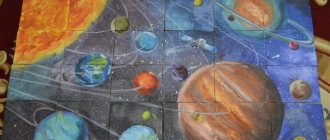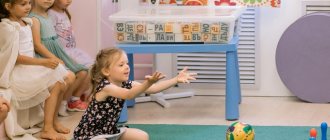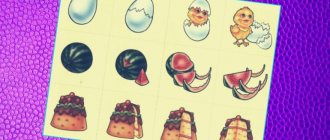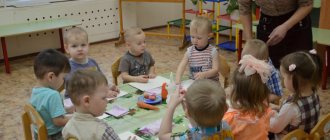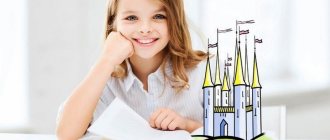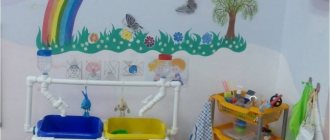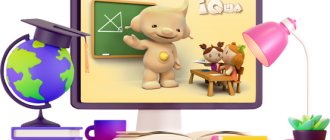Typically, kindergartens teach children 3-4 years old. Working in specialized programs, teachers give young preschoolers there the entire set of knowledge and skills they need. But there are also situations when a child cannot attend this institution or misses a lot due to frequent illnesses. Then the parents take charge of their child’s education themselves. Through systematic developmental activities for children 3-4 years old, even at home, children can learn everything that is appropriate for their age, if you know what and how to teach them.
How educational activities are carried out with children 3-4 years old at home
Homeschooling is a labor-intensive process that requires certain preparation of the parent and the right attitude. To work effectively, you need not only to think through the content of the lessons, but also to awaken the child’s interest in learning. What do you need to know?
Principles of organizing home activities
Any training, home or professional, must be carried out in accordance with the basic principles of pedagogy and take into account the age characteristics of the preschool child. What do you need to know?
- Firstly, for 3-year-old children the leading activity is play. Only by playing can a child be completely immersed in the learning process and firmly grasp the necessary knowledge.
- Secondly, all activities with the child must be systematic. Daily lessons, which are planned in advance, become more difficult as they are learned.
- Thirdly, the child’s activities should constantly change - alternate mental stress with physical exercise and creative tasks.
Conditions for conducting “lessons” for preschool children
At 3 years old, children are already able to concentrate for a long time on an object that interests them, and yet you should not plan too many tasks. The duration of classes for children 3 years old should be no more than 25 minutes, with a mandatory dynamic pause.
Thematic material:
- Educational games for 3 year old boys
- Games for girls 4 years old - educational
It is better to start work when the child has had time to rest and is in a good mood; they usually do it after breakfast or nap, every day at the same time.
While working, nothing should distract the baby’s attention - remove everything unnecessary from the table and out of sight.
Use bright props, handouts and manuals. You can buy them or make them yourself. To avoid losing interest in these learning tools, try not to play with them outside of class.
It’s good if all the exercises in the lesson are united by one plot. This will make it easier to keep the child’s attention.
Take a break from mental stress through physical exercises - dancing to music, walking along a line and an incline, playing with a ball, etc. They need to be included in every lesson.
Objectives and planning
The effectiveness of any work, including pedagogical work, depends on correctly set tasks and a clear plan for their implementation.
The main objectives of developmental activities for children 3-4 years old include the following:
- formation of thinking skills;
- development of motor skills, imagination and creativity;
- improving the sound and semantic aspects of speech, expanding vocabulary;
- formation of ideas about the phenomena and properties of objects, the surrounding world;
- education of personal qualities, teaching norms of behavior.
It is necessary to draw up a plan of developmental activities for children from 3 years old so that different types of activities alternate. Weekly planning will help you understand which exercise should be left, which one should be made more difficult, and which one should be put off for a while.
Environment and culture
I already understood the essence of the Montessori method, but my girl has grown up, and I simply don’t know what to offer for some new needs. My knowledge began to be lacking, so I took the course “Development and education of a child from 3 to 6 years old.” Below I will show you what I managed to do during training. I will complete the rest of the home activities as new points of interest for the child arise.
Previously, I gave my daughter information chaotically, but during the course I learned the structure of getting to know the world around me. That all ideas need to be materialized in order to be able to interact with objects. That a child after 3 years old needs to be led from simple to complex and from general to specific.
Now my daughter and I talk for a long time, observe and explore so that she can get to know physics, astronomy, biology and geography first-hand:
- We watch the moon, and my girl is always the first to notice the stars in the sky.
- When we wake up in the morning, we look out the window and discuss what the weather is like today.
- We conduct experiments in botany. Once I was doing a material on mathematics, I took 3 cones, and seeds fell out of them. We looked at them together and saw that they had blades like a helicopter. We discussed that they help seeds fly in the wind, and this makes the forest grow. This became the reason for studying the topic of why trees need seeds at all.
- Using the example of a dried rose, we saw where the stem, leaves, thorns are, and where the roots are. We pulled it out, planted spruce seeds in a pot, and now we are waiting for seedlings. I’ll make a sign, I’ll write the days on it and we’ll put a dash if nothing grows or a tick if sprouts appear.
And these are activity ideas for introducing a preschooler to geography: using a globe, we study land and water; using the world map we study continents and biomes (forest, sea, desert, mountains); using cards - national clothes, animals and traditions of different countries.
On the world map I tried to explain that the planet can be imagined as flat, but this is still difficult for a child a little over 3 years old. Now I’m preparing a story about the continents on cards
We have wonderful books about trees and birds (you can even listen to the singing of these birds). If I take these books and read them myself, Yulia joins in, but she doesn’t take them from the shelves. It’s good that she so clearly demonstrates the lack of a point of interest - it helps me choose other activities for development at home.
I recently bought a book about Marc Chagall at the museum. I plan to hold a presentation of cards with reproductions to begin to introduce the child to the history of art and instill taste.
Logic classes:
What should a child of 3 years old be able to do?
- find and explain the error;
- see similarities and differences;
- remember pictures and words;
- concentrate attention.
Three-year-old children move a lot and cannot sit still for long. If they lack physical activity, the child begins to get irritated, cry and become hysterical. It is important for a parent to remember this when planning an activity with their baby. The maximum lesson time should be 20 minutes. Before classes, it is better to do a ten-minute physical warm-up.
After the lesson, praise your offspring. Tell him that he did well and that he deserves encouragement. As a reward, you can take your baby to the park or some playroom.
Try to interest your baby in playing associations and opposites. Such exercises are good for training reaction speed, speech skills, and logical thinking.
At this age, children perfectly understand and love fairy tales and different stories. Tell them more often and make some mistake on purpose, and let the baby find it. For example, you say that winter has come, and then in the middle of the fairy tale the heroes go to the forest to pick mushrooms and berries.
The following exercise perfectly develops the logic and imagination of children: you show the child several cards that are related in meaning. And then invite your child to add another card that would fit into the story. For example, you show cards of mom, dad and child, and your kid can add a cat or a dog or a beautiful house here. And let him try to explain why he added this card.
Speech classes:
What should the baby learn?
- his sentences should consist of 5-6 words;
- he can say his first name, last name, and the names of his parents;
- knows how to distinguish objects by characteristics;
- understands the meaning of actions (walk, run, cry, search, play, etc.)
At home, you can invite your child to collect cubes or cards with letters so that he learns to collect words. In three-year-olds, the memory is not yet particularly developed, so give the tasks not difficult so that he can easily collect the hidden word.
Cognitive activities:
What should the baby learn?
- know some animals;
- know some plants;
- distinguish a vegetable from a fruit, a berry from a mushroom;
- know and understand natural phenomena (rain, snow, sun);
- distinguish the time of year and day.
Prepare images of various animals, birds and plants. Try to choose images of those plants and animals that you can find in your area. Then during your next walk you can show them to your baby and tell them some interesting facts and stories about them.
Sports activities:
Physical exercise is just as important for three-year-olds as intellectual exercise. When the child goes to school, he will be able to do all the exercises in physical education lessons. He will also be able to play outdoor games with classmates without any problems and will be able to show his endurance and dexterity. At this age, children strive to spend time with those with whom they find it interesting and fun. If your child is sedentary and inactive, the number of his friends may decrease sharply.
Start your morning with a simple invigorating exercise. Do some exercises to warm up your muscles and stretch. If you wish, you can start your morning with a run.
Girls love different dances, the main thing is that cheerful music is playing at this moment. Boys prefer playing with a ball. You can include all this in your daily routine and have fun together.
In any case, you will need all kinds of equipment to perform the exercises: small dumbbells, balls, a jump rope, hoops, and so on.
Three-year-old children are very inquisitive and smart. At this age, children develop their first habits. If you are able to correctly create a daily routine for your child and keep him busy with useful and educational exercises, your work will definitely be rewarded.
Methodology for conducting development classes in junior groups of preschool educational institutions
Since there are developmental goals in every lesson in kindergarten, it is possible to identify, and therefore trace, the general line of implementation of this area of work with children using the daily planning of children’s activities.
Table: example of daily planning in the first junior group (fragment)
| Author | Krasikova O. Yu., teacher of the combined type MBDOU No. 106, Angarsk, Irkutsk region. | ||
| First week of September | |||
| date | Morning | Walk | Evening |
| Monday | Meet the group. During the appointment, pay special attention to children who have a hard time parting with their parents, are capricious and cry for a long time. Outdoor game (F/n) “Fingers say hello.” Goal: development of speech, memory and fine motor skills. Offer the children a game with a dog that barks. Play out a scene with a dog, then sing a song about a dog. Learn to remember the location of toys in a group and put them in their place. | Watching the wind, how the wind blows, trees sway, leaves fall to the ground. P/i "Moth". Goals:
Remote material:
Help children get involved in the game, create a plot for the game “Doll Tanya is coming to visit.” Show how to make Easter cakes for a doll. | Introducing children to the doll corner. Goals:
During meals, ensure that children are seated correctly at the table. Learn correctly, hold a spoon and a mug, eat and drink without spilling. Conversations with parents about the behavior of children at home in order to identify the best experience of family education. |
| Tuesday | Greet children kindly and welcomingly. Pay special attention to children who have a hard time parting with their parents. Teach children to wash their hands before eating, roll up their sleeves, and wipe them dry with a personal towel. Introducing children to the construction corner. | Bird watching. What are they, shape, color, big and small. P/i "On the path." Purpose: to train children in walking in a limited area. Games for assignments (let's collect pebbles from the site). | Introducing children to the book corner. Viewing and reading the fairy tale “Ryaba Hen”. Goal: teach children to listen. Conversations with parents about how the child spent the day. Continue to teach children to remember the location of toys in the group room and put them in their place. |
| Quote from: https://nsportal.ru/detskii-sad/vospitatelnaya-rabota/2016/03/18/kalendarnoe-planirovanie-dlya-detey-rannego-vozrasta | |||
A daily plan helps distribute development tasks between different activities
Table: example of daily planning in the second junior group (fragment)
| Author | Pinchuk L.V., teacher at MBDOU D/s “Rodnichok”, Tambov. | |||||||
| Day of the week | Mode | Joint activities of adults and children, taking into account the integration of educational areas | Organization of a developmental environment for children’s independent activities (activity centers, all group rooms) | |||||
| Group, subgroup | Individual | Educational activities in special moments | ||||||
| Last week of September | ||||||||
| Monday | Morning:
|
Goals:
| Individual task for a child: “Bring a lot of leaves (one leaf).” |
| Didactic games:
Goal: enrich children's vocabulary and sensory experience. | |||
| Organized educational activities | Drawing "Beautiful stairs." Goals:
| |||||||
| Music according to the music director's plan | ||||||||
Preparing for a walk. Walk:
|
|
|
| Children running along paths with fallen leaves, listening to their rustling. Invite children to choose one sheet they like. | ||||
| Work before bed | Developmental game situation “Vegetables, fruits, berries” (using the poem by Y. Tuvim “Vegetables”, the fairy tale by K. Ushinsky “Know how to wait”). Goals:
| |||||||
Evening:
|
| With Polina B., Dima E. - conversation on the toy “Ball”, “Doll”. | Help situation “The mushrooms have scattered.” Goal: to develop interest in the actions of adults, the desire to help. | Looking at pictures on the topic “Where things grow” in a corner of nature. | ||||
| Walk | Labor assignment “Acorns and cones.” Goals:
| |||||||
| Tuesday | Morning:
|
| Didactic game with children “What did Mishutka bring us?” Goal: to consolidate the names of familiar vegetables and fruits. | A game with folk collapsible toys “Collect mushrooms into a basket.” Goals:
| Didactic game “Find and name the vegetables in the picture.” Goal: to consolidate children’s knowledge about vegetables, their shape, size, color. | |||
| Organized educational activities | FEMP "Quantity". Goal: to strengthen children’s ability to distinguish the number of objects using the words one, many, few. | |||||||
| Motor activity according to the plan of the physical education instructor | ||||||||
Preparing for a walk. Walk:
|
| Teach pure sayings with children. | Labor assignment: help adults remove dried plants from a flowerbed or bed, put them in a cart and take them to a certain place. | Didactic game “Weave a wreath.” Goal: learn to make colorful paths from leaves. | ||||
| Work before bed | Hand washing with fun:
| |||||||
Evening:
|
| Individual task for a child: “Take one toy (many toys).” | Children's stories "How we went to the forest." Goals:
| Drawing from a stencil “What grows in the garden?” | ||||
| Walk |
| |||||||
| Quote from: https://infourok.ru/plan-na-kazhdiy-den-vo-vtoroy-mladshey-gruppe-1764067.html | ||||||||
Daily planning helps track the dynamics of development goals
Lesson time plan
For children aged 1.5–4 years, any educational activity lasts 15 minutes. The teacher divides this time into 4 stages of working with the topic:
- Introduction to learning the material, as well as motivating kids and updating the knowledge, skills and abilities that kids already have - up to 2 minutes.
- The stage of presenting new information in conjunction with what children already know, as well as conducting physical education - up to 7 minutes.
- Reinforcement of material in practical tasks - up to 4 minutes.
- The summing up stage, including a positive assessment by the teacher of the activities of all children - up to 2 minutes.
Table: example of a lesson summary “Animals and their young” in the first junior group (fragment)
| Author | Medvetskaya O., teacher of MBDOU D/s "Romashka", town. Ust-Abakan, Republic of Khakassia. |
| Introduction | Children stand in a semicircle, the teacher reads a poem.
|
| Presentation of the material | <… Didactic game “Find the shadow”. Children match the shadow to the animals depicted on the presentation slides. Didactic game “Whose baby?” Children name the baby horse, cow, dog, etc. Finger gymnastics “Puppy”...> <... Didactic game “Who lives where?”. Q: Guys, do you think domestic animals could survive in the forest on their own? (No). Why? (There is no one to look after them). What danger awaits them? (They may be attacked by wild animals.) How does a person care for pets? (Feeds animals, prepares food for them, looks after them, builds houses)…> |
| Consolidation | <… Drawing “Kitten”. V.: Guys, let's draw a kitten. Only we will draw it in an unusual way, using the palm and the “dipping” method: a folded palm is the kitten’s body, fist-head, fingers-ears, eyes, nose, edge of the hand-paw, tail. |
| Summarizing | V.: Our lesson has come to an end. Today we learned a lot of new and interesting things about pets. Animals need to be given affection, care and love. |
| Quote from: https://www.maam.ru/detskijsad/konspekt-razvivayuschego-zanjatija-v-pervoi-mladshei-grupe-domashnie-zhivotnye-i-ih-det-nyshi.html | |
Different types of games are used in development classes: didactic, mobile, finger and theatrical
Table: example of lesson notes “Visiting the cat” in the second junior group (fragment)
| Author | Chekanova N. G., teacher at MBDOU D/s No. 1, Ozyorsk, Chelyabinsk region. |
| Introduction | The teacher invites the children to sit on the chairs, draws the children’s attention to the table, around which there are chairs, and toys sit on the chairs. V.: This is a house in which a cat and kitten live. Today is the little kitten's birthday. They are preparing to receive guests. The cat is setting the table, let's help her. |
| Presentation of the material | Q: What should you put on the table first? Children: Tablecloth. Q: What will we put in the middle and along the edges of the table? Children: Samovar, kettle, cups and saucers...> <... Knock on the door. V.: And here the guests have arrived. (The teacher goes to the door and brings in the duck and duckling). Guys, who is this? Children: Mother duck and little son duckling...> <... V.: It’s the kitten’s birthday, which means there will be a treat: fragrant tea and cookies. And now the animals invite you to play the game “Errands”...> <... V.: And now, guys, the animals will ask you riddles, and you will guess them according to the description. Duckling: It has a bottom and a handle. They drink tea from it. What is this? (Cup). Kitten: He has two arms and a nose. Water for tea is boiled in it, and it is pot-bellied. (Samovar)…> <… V.: And now the children will tell you their riddles. The teacher calls on those who want to ask a riddle. Helps children by whispering in their ears so that no one can hear. Everyone is heard. |
| Consolidation | V.: And now the animals want to play another game with you, “Whose voice is that?” Toys are played out - the voices of animals and their cubs - a rough, thin, soft voice. |
| Summarizing | The teacher thanks the kids for their work. |
| Quote via: https://nsportal.ru/detskiy-sad/razvitie-rechi/2014/10/26/seriya-zanyatiy-dlya-2-mladshey-gruppy | |
Video: lesson on speech development on the topic “Hen and Chicks” in the first junior group
Video: FEMP lesson on the topic “Travel with Kolobok” in the second junior group
Household activities:
What should the baby learn?
- must be able to dress and undress independently;
- cut out various pictures;
- color pictures;
- must understand the basic rules of accuracy.
Parents often hang posters and pictures around the house with hygiene rules. Every time a baby passes by, he remembers and remembers that he needs to wash his face and brush his teeth regularly.
Try to develop creative skills in your son or daughter. Once every 1-2 months, organize holidays or celebrations at home, for which you need to prepare costumes, decorations, etc. Involve your baby in the preparation. Let him help you.
If you don’t have enough time to organize holidays, make crafts together from different materials. Remember to use pine cones, leaves, acorns and other natural materials.
